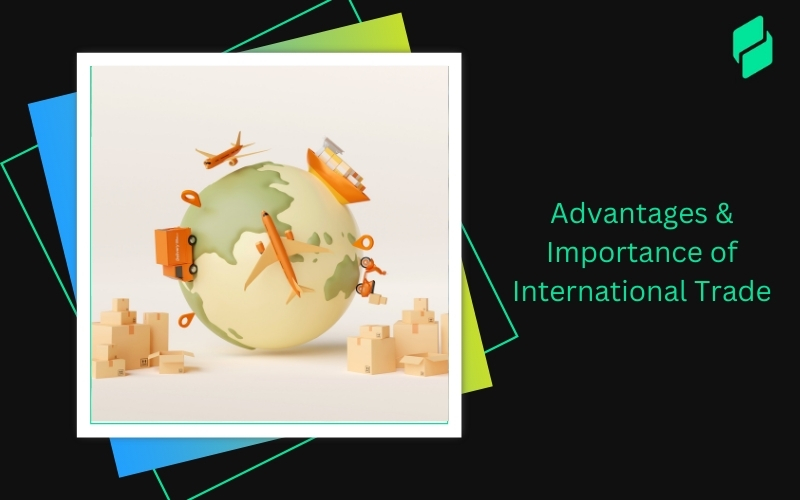Do you want to avoid dealing with payment delays in your export business? An Electronic Bank Realization Certificate (e-BRC) is a game-changer for those in the export industry. Banks provide a digital certificate to confirm that exporters have received payment from importers for the goods shipped.
In a time when India's exports hit $69.72 Billion in January 2024, up 9.28 per cent from the previous year, the role of e-BRC in streamlining export transactions is more important than ever.
In this article, we'll dive into how e-BRC is making life easier for exporters and why it's essential for a smooth and profitable export business, especially in the dynamic world of ocean shipping.
Optimize your business: use unlimited savings with Pazago fulfilled now!
Get Started ->What is BRC in Export?
Definition: A Bank Realization Certificate (BRC) is a crucial document banks issue to confirm that an exporter has received payment from an importer for the products shipped. It serves as a financial passport in the export business.
Process: Before shipping, exporters must inform their bank about the value of the goods intended for export. Once the payment is received, the banks record the transaction in the Export Data Processing and Monitoring System (EDPMS).
What is e-BRC In Export?
The e-BRC, or Electronic Bank Realization Certificate, is a digital tool that streamlines the process of accessing various export incentives such as duty exemptions, subsidies, and low-cost loans offered under the Foreign Trade Policy.
Advantages:
Unlike the traditional process, the e-BRC system is online and paperless. Banks can upload documents directly to the DGFT server and foreign exchange information related to exports. This makes the process secure and efficient.
Integration
Integrating e-BRC into the banking system allows the DGFT to easily access information on shipping bills and foreign exchange realization.
This data matches the shipping bill details, including the Freight on Board (FOB) value, to accurately determine export incentives.
Benefits for Exporters
For every export transaction, exporters must submit all shipping bills to their bank. After receiving the payment, the bank issues an e-BRC against the shipping bill payments and marks the transaction as complete in the EDPMS.
The e-BRC is a key to accessing various export benefits under the Foreign Trade Policy and is an essential proof of payment realization for businesses seeking export incentives.
Now that we've cracked open what e-BRC is all about, let's dive into how it functions in the wild, shall we?
How Does e-BRC In Export Work in India?
The e-BRC is a digital certificate issued by banks to confirm that an exporter has received payment for exported goods or services. Here's a step-by-step guide to how the process unfolds:
- Payment Receipt: Once you, as an exporter, receive payment for your goods or services, your bank generates an e-BRC certificate digitally. This is the first step in ensuring your financial transactions are recorded and acknowledged.
- XML File Generation: Next, your bank creates an XML file containing all the essential details of the e-BRC. This file is a digital record that ensures all information is accurately captured and ready for submission.
- Signing and Registration: The XML file is then signed using the Directorate General of Foreign Trade's (DGFT) signer. Banks must register this signer with the DGFT to ensure a secure and authenticated process.
- Uploading to DGFT Server: The signed XML file is uploaded to the DGFT server via their website. This is where the digital magic happens, as your e-BRC data is securely transferred to the relevant authorities for review.
- Verification and Acknowledgement: The DGFT reviews the XML file and verifies the information. Once everything checks out, the DGFT sends an acknowledgment to your bank, confirming the successful verification of your e-BRC.
- Accessing Your e-BRC: As an exporter, you can log in to the DGFT website, check the status of your e-BRC, and take a printout if needed. This digital document is proof of payment realization and a key to accessing various export benefits.
Are you feeling ready to get your hands on an e-BRC? Follow me as we navigate through the steps together.
Acquiring e-BRC In Export: The Process
Here's how you can easily access your Electronic Bank Realization Certificate (e-BRC) on the DGFT website, ensuring you're all set to claim your export incentives.
- Start by Registering: First things first, register on the DGFT website. This is your gateway to a world of resources and information related to exports.
- Navigate to Your Dashboard: Once registered, head to “My Dashboard” and select the "Repositories" option. This is where all your essential documents and information are stored.
- Explore Your Bills Repository: Click the "Explore" button under the "Bills Repositories" tab. This is where you'll find records of all your transactions and certificates.
- Select Your Bill Type: From the "Select Bill" drop-down menu, choose "Bank Realisations (e-BRC)." This will filter your search to show only your bank realization certificates.
- Set Your Date Range: Enter the "From Date" and "To Date" to define the period you want to view the e-BRCs. This helps narrow down your search to the relevant time frame.
- View Your e-BRCs: All e-BRCs uploaded by your banks will be displayed on the screen. You can now see all your certificates in one place.
- Choose Your e-BRC: To view a specific e-BRC, select the bank realization number. This will bring up the details of that particular certificate.
- Review Your e-BRC Details: The information about the e-BRC will appear on the screen. Take a moment to review all the details and ensure everything is correct.
- Download Your e-BRC: To download the e-BRC, select the 'Print eBRC' option. You can save a copy of the certificate for your records or use it to claim export benefits.
Navigating the DGFT website and managing e-BRCs can be complex. Pazago offers personalized guidance and digital solutions that ease the acquisition and management of e-BRCs, making it easier for exporters to focus on their core business.
Got your e-BRC, and what's next? Let's check its pulse on the DGFT website.
How can you Check the e-BRC In Export status on the DGFT Website?
Are you navigating the e-BRC status on the DGFT website? Here's a step-by-step guide to ensure your export documentation is error-free and up to date.
- Start at the DGFT Website: Head to the official DGFT website and find the "Services -> eBRC" section. It's usually at the end of the list of options, so scroll down to locate it.
- View Your e-BRC: Select "View and print your eBRC" from the available options. This will take you to the "e-BRC Details for Trade" page.
- Enter Your Details: On this page, you must input your Import Export Code (IEC) and your bank's IFSC code. These details are crucial for accessing your specific e-BRC records.
- Show Details: Click on the "Show Details" button to reveal all the e-BRCs uploaded by your bank. Here, you can review the status of each certificate and ensure everything is in order.
Correcting Errors in Your e-BRC
- Identify Errors: If you spot an error in your e-BRC while checking its status, it's essential to address it promptly. Since e-BRCs cannot be directly amended, you must take the following steps to correct any inaccuracies.
- Contact Your Bank: Contact your bank to request the correction. Explain the issue clearly and provide any necessary documentation to support your request.
- Cancellation and Reissuance: If your e-BRC has not been 'used' or 'utilized,' your bank can cancel it. They do this by uploading the e-BRC to the DGFT's server with a C (cancellation) status.
- Getting a New e-BRC: After the DGFT updates the cancellation status, your bank will issue and upload a new e-BRC with a fresh (F) status. This new certificate will have a new e-BRC number and reflect the corrected details.
- Download the Corrected e-BRC: Once the new e-BRC is uploaded, you can follow the initial steps to download or print the corrected certificate from the DGFT website.
Errors in e-BRCs can be a significant hindrance in claiming export incentives. Pazago’s platform offers meticulous management of e-BRCs, helping businesses quickly identify and rectify errors with minimal hassle.
Before you dash off to claim your e-BRC, pause and ensure you have these documents in order.
Essential Documents for Obtaining DGFT e-BRC
Securing your Electronic Bank Realization Certificate (e-BRC) is a crucial step. Here's a rundown of the critical documents you'll need to ensure a smooth process.
1. Business Name and Address
Your business name and address are the foundational details required to obtain a BRC from your bank. This information establishes your business identity and location, which is crucial for any financial transaction related to exports.
2. IEC (Import Export Code)
The IEC is a mandatory document for receiving a BRC. It's your unique identification code for engaging in export and import activities. With it, you can obtain your e-BRC, a key identifier for your business in international trade.
3. Shipping Bill
The shipping bill is a vital document that contains details such as the bill number, invoice number, port of dispatch, and more. Obtaining a BRC is essential as it provides proof of your export transaction and the specifics of the goods being shipped.
4. Bank Details
Last but not least, your business's bank details are required. This includes your bank account number, IFSC code, and the branch details. These details are crucial for the bank to process your e-BRC, as they tie your financial transactions to your export activities.
Alright, you've got your e-BRC – what's the payoff? It's time to unlock those export incentives.
Claiming Export Incentives Using e-BRC
Unlocking export incentives is crucial for maximizing your profits. Here's how to leverage the Electronic Bank Realization Certificate (e-BRC) to claim these benefits in India.
1. Understanding the Role of DGFT
The Directorate General of Foreign Trade (DGFT) decides the value of incentives you can claim. This value is determined based on the Free Board (FOB) value of your exported goods and services, as mentioned in the shipping bills, and the total payments received per the e-BRC.
2. Submitting Shipment Bills
To kickstart the process, submit all your shipment bills on the Indian Customs Electronic Data Interchange Gateway (ICEGATE platform). This platform serves as a digital gateway for all your customs-related transactions.
3. Linking Shipping Bill with e-BRC
Once submitted, ICEGATE automatically shares the bill information with the DGFT. At this stage, you need to link the relevant shipping bill with the e-BRC to stake your claim for export benefits. This linkage is crucial for the DGFT to verify the details of your export transactions.
4. Analyzing FOB Value
The DGFT will analyze the FOB or consolidated realization value for multiple products. The incentive is calculated based on the lower value between the two. This ensures that the incentives are pretty distributed and correspond to the actual value of the exported goods.
5. Ensuring Error-Free e-BRC
It's essential to ensure that the bank has submitted an error-free e-BRC. This certificate should reflect the consolidated realization value accurately. Any discrepancies can lead to delays or rejections of your incentive claims.
6. Entering Additional Values
You must enter additional freight, insurance, and commission values in your refund application. These are excluded from the e-BRC but are essential for calculating the total value of your export transaction.
Businesses need a robust system to fully leverage the potential of e-BRC in claiming export incentives. Pazago's suite of products facilitates this, ensuring that your documents align perfectly with regulatory requirements for a smooth claim process.
Conclusion
In conclusion, the Electronic Bank Realization Certificate (e-BRC) is vital for Indian exporters. It streamlines payment verification and incentive claims, enhances efficiency, reduces paperwork, and improves financial credibility.
For optimal benefit, exporters should embrace e-BRC, ensure accuracy in export records, and regularly monitor their e-BRC status on the DGFT website.
By strategically leveraging e-BRC, Indian exporters can navigate global trade more effectively, unlocking more significant opportunities and profitability in their export endeavors.
Embracing e-BRC is just the beginning. Platforms like Pazago further empower exporters by simplifying global trade operations, enhancing documentation efficiency, and providing strategic insights for business growth, making it an essential partner in navigating the complexities of international trade.


.png)








